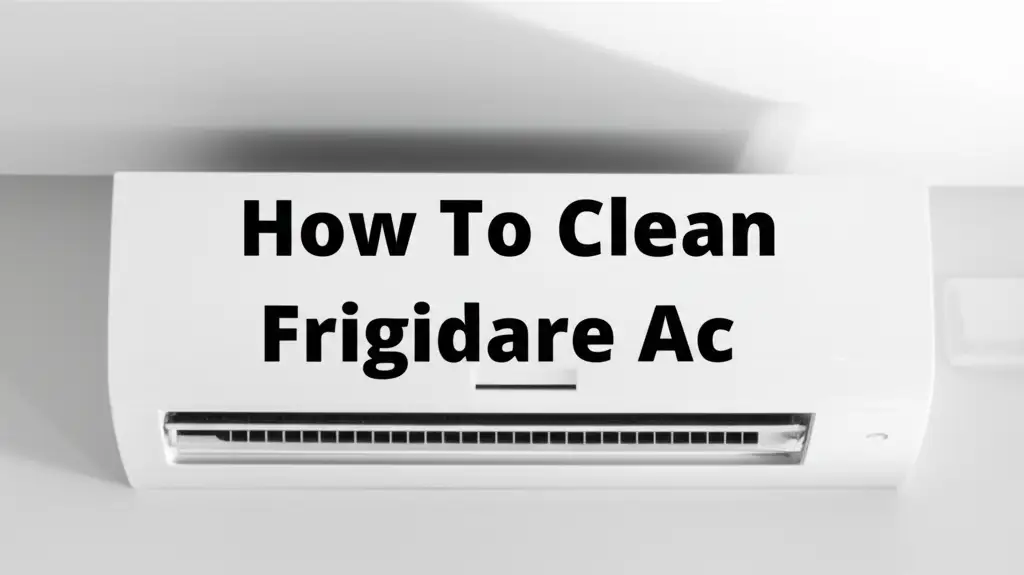· Home Maintenance · 19 min read
How To Clean Mold From Window Air Conditioner

Restore Your Air: How to Clean Mold From Window Air Conditioner
Have you noticed a musty smell coming from your window air conditioner? Or perhaps you can see black spots forming on its grilles or internal components? You are likely dealing with mold. Mold growth in your AC unit is not just unsightly; it can also affect air quality and your health. Knowing how to clean mold from window air conditioner units is essential for a healthy home.
Ignoring mold in your AC unit can lead to poor performance and health risks. Mold spores spread through the air, causing allergies or respiratory problems. This guide will help you understand why mold grows, what tools you need, and how to safely and effectively remove it. We will walk you through each step of the cleaning process. You will learn to clean filters, coils, and drain pans. Finally, we will provide tips to prevent mold from returning.
Takeaway: Restore Your AC, Breathe Freely
- Safety First: Always unplug the unit and wear protective gear.
- Deep Clean: Dismantle accessible parts and clean all components thoroughly.
- Mold Solutions: Use natural or chemical cleaners, ensure proper ventilation.
- Drainage Matters: Clear the drain pan and line to prevent moisture build-up.
- Prevent Future Growth: Regular maintenance and proper humidity control stop mold return.
How do you effectively clean mold from a window air conditioner?
To effectively clean mold from a window air conditioner, first unplug the unit for safety. Then, remove the front panel and air filter. Use a diluted bleach solution (1 part bleach to 16 parts water) or a vinegar solution (equal parts water and white vinegar) to scrub away mold from the filter, coils, fins, and drain pan. Rinse thoroughly, ensure proper drainage, and allow all parts to dry completely before reassembly.
Why Mold Grows in Your Window AC Unit
Mold thrives in specific conditions. It needs moisture, warmth, and a food source. Your window air conditioner provides the perfect environment for mold to grow. It constantly pulls warm, humid air from outside into a cool, dark space.
As the AC cools the air, moisture condenses on the cold coils. This water drips into a drain pan. If this water does not drain properly, it sits there. Stagnant water creates a damp environment inside the unit. Dust, dirt, and pet dander accumulate on coils, fins, and filters. These particles become a food source for mold spores.
Poor airflow also contributes to mold growth. If the unit is not running efficiently, air does not circulate well. This allows moisture to linger inside. Blocked filters or dirty coils reduce airflow. This trapped moisture encourages mold to spread rapidly. Regular cleaning prevents these conditions. It stops mold from establishing itself in your AC unit.
Essential Safety Gear and Tools for Mold Removal
Cleaning mold requires proper preparation. You need to protect yourself from mold spores and cleaning chemicals. Gathering the right tools before you start makes the job easier and safer. Do not skip these important steps.
Safety Gear You Will Need:
- Gloves: Wear thick rubber gloves. These protect your hands from mold and cleaning solutions.
- Safety Glasses or Goggles: Protect your eyes from splashes and mold spores.
- N95 Respirator Mask: This mask filters out mold spores. It prevents you from inhaling them. This is crucial for respiratory health.
- Old Clothes: Wear clothes you do not mind getting dirty or stained.
Cleaning Tools and Materials:
- Bucket: For mixing cleaning solutions.
- Stiff Brush or Scrub Brush: To scrub stubborn mold.
- Soft Brushes/Paintbrush: For delicate fins and coils.
- Screwdriver Set: To open the AC unit casing.
- Vacuum Cleaner with Hose Attachment: To remove loose dust and debris.
- Spray Bottle: For applying cleaning solutions.
- Microfiber Cloths or Rags: For wiping surfaces clean.
- Pipe Cleaner or Wire Brush (small): For cleaning the drain line.
- Water Source: For rinsing.
- Wet/Dry Shop Vacuum (Optional): For larger water spills or more thorough cleaning.
Cleaning Solutions:
- White Vinegar: A natural mold killer. Mix equal parts white vinegar and water in a spray bottle. This is a common and effective cleaning agent. Many people use vinegar for cleaning various items, including their dishwashers. How To Clean Dishwasher With Vinegar And Baking Soda
- Bleach Solution: For tough mold stains. Mix 1 cup of bleach with 1 gallon of water. Use this sparingly and in a well-ventilated area. Bleach can damage some materials if not used correctly.
- Hydrogen Peroxide: A milder alternative to bleach. Use a 3% solution directly or diluted with water.
- Coil Cleaner: You can buy specialized AC coil cleaner. Follow product instructions carefully.
Always work in a well-ventilated area. Open windows and use fans if possible. This helps to disperse fumes and mold spores. Prepare your workspace before you begin. Lay down old towels or newspapers to protect your floor.
Pre-Cleaning Steps: Disconnecting and Opening Your AC Unit
Before you start cleaning, prepare your window AC unit. This ensures your safety and makes the cleaning process more efficient. Do not rush these initial steps. Proper preparation prevents accidents and damage to your unit.
Step 1: Disconnect Power
This is the most critical step. Locate the power cord of your window AC unit. Unplug it from the wall outlet. Never attempt to clean an electrical appliance while it is still plugged in. This poses a serious risk of electric shock. Confirm the unit is completely off and unplugged before touching any part of it.
Step 2: Move the Unit (Optional but Recommended)
For a thorough cleaning, it is best to remove the AC unit from the window. Place it on a protected surface, like a large tarp or old towels, in an area where you can easily access all sides. A garage, basement, or even an outdoor patio works well. Choose a spot that has good ventilation. If removing the unit is difficult or not possible, you can still clean it while it is in the window. However, cleaning it outside allows for easier access and mess containment. For tips on cleaning without removing the unit, you can refer to resources on How To Clean Window AC Unit Without Removing.
Step 3: Remove the Outer Casing and Front Panel
Most window AC units have a removable front grille or panel. Look for tabs, clips, or screws that hold it in place. Use a screwdriver if needed. Carefully detach the front panel. Set it aside for cleaning.
Next, you will need to access the internal components. This usually involves removing the outer metal casing. There are typically several screws holding the casing in place. These screws are often on the sides, top, or back of the unit. Keep track of all screws. Place them in a small container so you do not lose them. Once all screws are removed, slide or lift the casing off. You will now see the internal parts: the air filter, evaporator coils, condenser coils, and the drain pan. Take a moment to observe how everything fits together. This helps with reassembly later.
Cleaning Mold from AC Filters and Front Panel
The air filter and front panel are the first lines of defense against dust and debris. They often show the first signs of mold growth. Cleaning these parts is simple but crucial for air quality.
Step 1: Remove and Clean the Air Filter
Carefully slide out the air filter from its slot. This is usually located behind the front panel. Most window AC units use reusable, washable filters. If your filter is disposable, throw it away and replace it with a new one.
For a washable filter, take it outside or to a utility sink. Use a vacuum cleaner with a brush attachment to remove loose dust and large debris. Next, create a cleaning solution. You can use a mixture of warm water and a few drops of dish soap. Alternatively, prepare a 50/50 solution of white vinegar and water in a spray bottle. Spray the filter thoroughly with the chosen solution. Let it sit for 5-10 minutes. Use a soft brush to gently scrub the filter. Make sure to get into the crevices to remove all visible mold and grime. Rinse the filter thoroughly under running water until all soap and mold residue are gone. Ensure the water runs clear. Allow the filter to air dry completely before putting it back into the unit. A damp filter can promote mold regrowth.
Step 2: Clean the Front Panel and Grille
The front panel and grille are often exposed to condensation and dust. This makes them prone to mold spots. Use a soft cloth or sponge with your chosen cleaning solution. A mixture of equal parts white vinegar and water is very effective here. Spray the solution directly onto the panel and grille. Let it sit for a few minutes. Then, wipe away all visible mold and dirt. For stubborn spots, use a stiff brush or an old toothbrush.
Ensure you clean all sides and crevices of the panel and grille. Rinse the panel with clean water if possible. Wipe it down with a clean, damp cloth. Allow the front panel and grille to dry completely before reattaching them. You can use a clean towel to speed up the drying process. A thoroughly cleaned filter and panel prevent mold spores from re-entering your living space.
Deep Cleaning AC Coils and Fins: Tackling Stubborn Mold
The evaporator and condenser coils, along with their delicate fins, are critical for cooling. They are also prime spots for mold due to constant condensation and trapped debris. Cleaning these areas requires care.
Step 1: Vacuum Loose Debris
Before applying any liquid cleaners, use a vacuum cleaner with a brush attachment. Carefully vacuum the surfaces of both the evaporator coils (inside the unit) and the condenser coils (outside the unit, if accessible). Remove any loose dust, lint, pet hair, or other debris. This step prevents the debris from turning into muddy residue when wet. Be gentle around the fins; they bend easily.
Step 2: Apply Mold Cleaning Solution to Coils
Choose your cleaning solution:
- White Vinegar Solution: Mix equal parts white vinegar and water in a spray bottle. This is a natural, safe option.
- Bleach Solution (Caution): Mix 1 cup of bleach with 1 gallon of water. Use this for very heavy mold, but apply it carefully. Bleach can be harsh and may damage some components if overused. Ensure good ventilation.
- Commercial Coil Cleaner: Follow the product’s instructions. These cleaners are designed to penetrate and break down grime.
Spray your chosen solution generously onto both the evaporator and condenser coils. Make sure to saturate the moldy areas. Allow the solution to sit for 10-15 minutes. This gives the cleaner time to break down the mold and grime. For effective cleaning, consider using vinegar and baking soda solutions which are popular for many cleaning tasks. How To Clean With Vinegar And Baking Soda
Step 3: Gentle Scrubbing and Rinsing
Use a soft-bristled brush or an old paintbrush to gently scrub the coils and fins. Work carefully between the fins. Do not apply too much pressure. The fins are very thin and can bend easily. Bent fins restrict airflow and reduce efficiency. If fins are bent, you can use a fin comb (a specialized tool) to straighten them.
After scrubbing, you need to rinse the coils. For the evaporator coils (inside), you can use a spray bottle filled with clean water. Spray to rinse the solution and dislodged mold down into the drain pan. For the condenser coils (outside), you can use a garden hose with a gentle spray nozzle. Aim the spray from the inside out to push dirt away from the unit. Be careful not to get electrical components wet. Collect the runoff water in the drain pan or a bucket if you are cleaning the unit outside. Ensure all mold residue and cleaning solution are thoroughly rinsed away. Proper rinsing is important to prevent residue buildup.
Clearing the Drain Pan and Line: Preventing Future Mold
The drain pan and drain line are vital for moisture management in your AC unit. They collect and remove condensed water. If they become clogged or dirty, water accumulates, creating an ideal breeding ground for mold.
Step 1: Locate and Clean the Drain Pan
The drain pan is usually located directly beneath the evaporator coils. It collects the water that condenses on the coils. Carefully remove any standing water from the drain pan. You can use a wet/dry shop vacuum or sponges and towels for this.
Once the pan is empty, you will likely see mold, algae, or sludge. Spray the drain pan with your chosen mold cleaning solution. Again, a vinegar solution (equal parts white vinegar and water) works well. Let it sit for 10-15 minutes. Use a stiff brush or scrub brush to thoroughly clean the entire surface of the pan. Pay attention to corners and edges where grime accumulates. Rinse the pan with clean water. Ensure all mold and cleaning solution residue are gone. You may need to tilt the unit slightly to help water drain completely from the pan during rinsing.
Step 2: Clear the Drain Line
The drain line carries water from the drain pan out of the unit. This line can become clogged with mold, algae, and debris. A clogged drain line causes water to back up in the pan, leading to leaks and more mold growth.
Locate the drain opening in the pan and follow the line. It usually exits through the back or side of the unit. Use a small pipe cleaner, a flexible wire brush, or a straightened coat hanger to clear any blockages in the drain line. Push it gently through the line to dislodge buildup.
You can also flush the drain line. Mix a solution of 1 part bleach to 16 parts water, or use plain white vinegar. Carefully pour about 1 cup of this solution into the drain pan. It should flow through the drain line and exit the unit. If the solution backs up, the line is still clogged. Repeat the clearing process. Alternatively, for stubborn clogs, consider using an air compressor to clear the line. This method is effective for various AC units, and you can find more details on How To Clean AC Drain Line With Air Compressor. Ensure the water drains freely. This step is crucial for preventing future mold growth.
Cleaning the Blower Fan and Reassembly
The blower fan circulates air throughout your room. It can accumulate dust and mold, impacting airflow and air quality. Cleaning it is important for thorough mold removal.
Step 1: Clean the Blower Fan (Squirrel Cage)
The blower fan, often called a squirrel cage fan, is usually located behind the evaporator coils. It can be tricky to access. If your unit allows, you can remove the blower wheel for easier cleaning. However, many models make this difficult without extensive disassembly. For tips on cleaning without removing, refer to guides on How To Clean AC Blower Wheel Without Removing.
If you can access the fan, use a stiff brush or an old toothbrush to loosen accumulated dust and mold from the fan blades. Be gentle to avoid bending the blades. You can also use a vacuum cleaner with a narrow attachment to suck up loose debris. Then, spray the fan blades with your chosen mold cleaning solution. Let it sit for a few minutes. Use a damp cloth or brush to wipe away the loosened mold and grime. Ensure all surfaces of the fan blades are clean. Rinse with a spray bottle of clean water if possible. Wipe down thoroughly.
Step 2: Clean the Interior Casing and Electrical Components
Before reassembly, wipe down the interior surfaces of the AC unit’s casing. Use a damp cloth with your cleaning solution. Remove any dust or mold spores that may have settled during the cleaning process. Be extremely careful around electrical components. Do not spray water or cleaning solutions directly onto wiring, circuit boards, or the compressor. If any electrical parts look dusty, gently wipe them with a dry cloth or use compressed air.
Step 3: Allow All Parts to Dry Completely
This step is critical for preventing immediate mold regrowth. Every component you cleaned must be completely dry before reassembling the unit. Mold thrives in moisture. If you reassemble a damp unit, mold will likely return quickly.
You can air dry the parts naturally in a well-ventilated area. Using a fan can speed up the drying process. For larger parts like the casing and filter, direct sunlight helps too. Ensure there is no moisture left on the coils, in the drain pan, or on the fan blades. This might take several hours, or even overnight, depending on humidity levels. Patience here saves you from having to repeat the cleaning process soon.
Step 4: Reassemble the Unit
Once all parts are dry, carefully reassemble your window AC unit.
- First, place the clean drain pan back into its position.
- Next, fit the blower fan back into place if you removed it.
- Then, gently slide the main internal assembly back into the outer casing. Ensure all wires are clear and not pinched.
- Secure the outer casing with the screws you removed earlier.
- Finally, reinsert the dry air filter and attach the front panel or grille. Make sure all clips or screws are secure.
After reassembly, carefully place the unit back in the window if you removed it. Ensure it is securely installed. Then, plug the unit back into the power outlet. Your window AC unit is now clean and ready to provide fresh, cool air.
Post-Cleaning Maintenance and Mold Prevention Tips
Cleaning your window AC unit is a significant step. However, preventing mold from returning is equally important. Regular maintenance habits keep your air conditioner running efficiently and mold-free.
Regular Filter Cleaning
The air filter is your first defense against mold. It traps dust and allergens. A dirty filter reduces airflow and creates a damp environment inside the unit. Clean your reusable air filter at least once a month during peak usage. If you have pets or allergies, clean it more often. If your unit uses a disposable filter, replace it regularly as recommended by the manufacturer. This simple step significantly reduces the likelihood of mold growth.
Ensure Proper Drainage
Blocked drain lines are a primary cause of mold in AC units. Check the drain pan and line periodically. Ensure water drains freely from the unit. If you notice water pooling in the pan, clean the drain line immediately. You can pour a cup of white vinegar down the drain line every few months as a preventative measure. The vinegar helps to kill any incipient mold or algae before it becomes a problem.
Control Indoor Humidity
Mold needs moisture to grow. High indoor humidity levels create an inviting environment for mold. Aim for an indoor humidity level between 30% and 50%. Your AC unit helps dehumidify the air as it cools. However, in very humid climates, you might need a separate dehumidifier. Running exhaust fans in bathrooms and kitchens also helps reduce humidity. Ensure proper ventilation in your home.
Schedule Annual Deep Cleaning
Even with regular maintenance, your window AC unit benefits from a deep clean once a year. The best time for this is before the cooling season begins. This allows you to address any hidden mold or buildup from the previous year. You can follow the steps outlined in this guide for a comprehensive annual cleaning. A professional AC technician can also perform this service. They can identify and fix issues you might miss.
Ventilate Your Home
Fresh air circulation helps prevent stale, damp air indoors. Open windows and doors when the weather permits. Use ceiling fans to circulate air. This helps dry out any lingering moisture and reduces humidity levels. Good ventilation also helps disperse mold spores that might enter your home.
Consider Anti-Mold Treatments
Some HVAC supply stores sell anti-mold or anti-bacterial sprays for AC coils. These products can inhibit mold growth. Apply them after a thorough cleaning, following the product’s instructions carefully. These treatments can add an extra layer of protection against mold. Always choose products safe for use in residential environments.
By implementing these maintenance tips, you ensure your window AC unit remains a source of cool, clean air. You also protect your home and family from the negative effects of mold.
Frequently Asked Questions About Cleaning Mold From Window Air Conditioner
Q1: What are the health risks of mold in a window AC unit?
A1: Mold in an AC unit can release spores into the air. Inhaling these spores can cause various health issues. Common symptoms include allergic reactions like sneezing, watery eyes, and skin rashes. It can also trigger asthma attacks or cause respiratory problems in sensitive individuals. Prolonged exposure may lead to more severe health conditions.
Q2: Can I use bleach to clean mold from my AC unit?
A2: Yes, you can use a diluted bleach solution (1 part bleach to 16 parts water) for tough mold. However, use it with caution. Ensure excellent ventilation. Avoid direct contact with skin and eyes. Rinse thoroughly after application, as bleach can be corrosive and leave a residue. Vinegar or commercial coil cleaners are often preferred as safer alternatives.
Q3: How often should I clean my window AC unit to prevent mold?
A3: Clean your air filter at least once a month during peak use. Perform a more thorough deep cleaning, including coils and the drain pan, at least once a year. The best time for deep cleaning is before the cooling season begins. If you live in a very humid area or notice a musty smell, clean more often.
Q4: What if I still smell mold after cleaning my AC unit?
A4: A lingering mold smell suggests you missed some mold. This might be in less accessible areas like the blower wheel, fan motor housing, or deeper in the drain line. Re-examine these areas. You may need to use a stronger mold killer. If the smell persists, consider consulting a professional HVAC technician. They have specialized tools for deeper cleaning and inspection.
Q5: Can mold damage my window AC unit permanently?
A5: Yes, prolonged mold growth can damage your AC unit. Mold buildup on coils reduces efficiency, making the unit work harder. This can lead to increased energy consumption and premature wear on components. Severe mold can also corrode metal parts, especially in the drain pan and coils, leading to leaks or unit failure over time.
Q6: Is professional cleaning necessary for AC mold?
A6: For mild to moderate mold growth, DIY cleaning is usually effective. However, if the mold is extensive, deeply embedded, or you are uncomfortable with the process, professional cleaning is recommended. HVAC technicians have specialized equipment and expertise. They can safely and thoroughly remove mold, ensuring no hidden spots are missed.
Conclusion
Cleaning mold from your window air conditioner is a crucial task for your health and the unit’s efficiency. You have learned how to safely prepare for the job. You know how to meticulously clean each component, from the filter to the coils and drain pan. We covered the importance of thorough drying and proper reassembly.
Regular maintenance is key to preventing mold recurrence. Cleaning your filter often and ensuring good drainage keeps your unit running optimally. Controlling indoor humidity also helps prevent future mold growth. Taking these steps ensures your AC unit provides cool, clean air without the hidden dangers of mold. Your diligence in learning how to clean mold from window air conditioner units will result in a healthier, more comfortable home. Get started today and enjoy cleaner air tomorrow!
- window AC cleaning
- mold removal
- air conditioner maintenance
- DIY cleaning
- AC mold prevention




